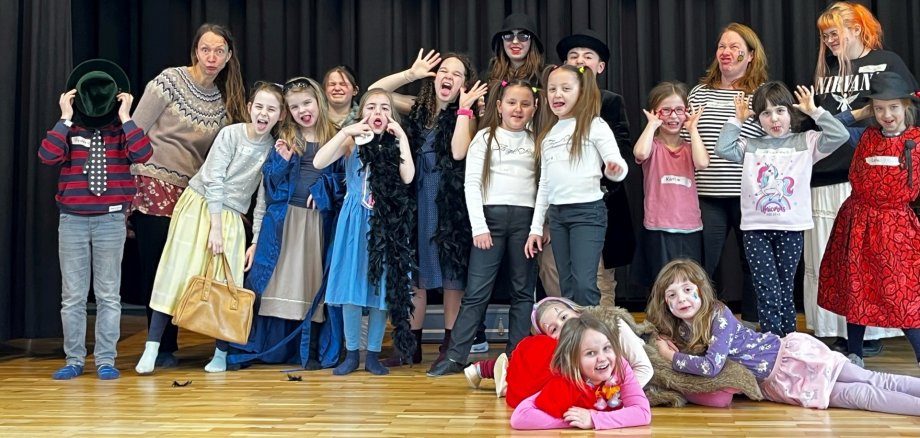After the first games to get to know each other, the stage in the assembly hall was immediately used to try things out: Speech exercises were performed, emotional states were portrayed and different ways of walking - such as striding, strutting, strolling, marching or sneaking - were tried out. Sometimes the whole group of people moved, other times just one person moved through the loosely arranged group. Sometimes meandering, sometimes hurrying, but always with the aim of keeping an eye on the others, paying attention to them and communicating with them. With or without dialog.
In short improvisation units, small groups then combined characters with the location and the corresponding situation. The players were asked to get to grips with the character, but also with the situation, to interact with each other and to start a conversation. As the action progressed, a third and possibly a fourth person was added to the scene.
All the children introduced themselves to the others in roles they had invented themselves: Sabrina, a hairdresser working in Paris and living in Germany, who shuttles back and forth between her beauty salons in her private jet. Her customers, Lara and April, who keep nothing less than a unicorn as a pet and come to the salon at least three times a week, where they also have their make-up done by Scarlett, a well-known make-up artist.
The extremely obedient pupils of Ms. Pfeiffer and Mr. Schmidt - who, in addition to being a teacher, is a recreational captain who spends the money he inherited from his grandfather on his yacht in New Zealand - complete all the work stringently and without grumbling, without exception. Those who have completed their worksheets are allowed to go into the break early, which clearly pleased both the students and the teachers.
The crooks Bonnie and Clyde had a rendezvous in Mrs. Schneider's supermarket. They shopped without paying, were caught by the attentive cashier and eventually caught by the police.
In all the short play scenes, the children developed their dialog themselves. Acting out the dialog also means inserting pauses, speaking slowly or slowly, hastily or quickly, conciliatory or aggressive, demanding or placating. Together with the non-verbal actions, the children let their texts take shape with facial expressions, gestures and movement, bringing them to life.
Various costumes and Nele Schmidtberger's make-up made the little actresses look perfect and they all presented the scenes together in a small performance in front of their parents, siblings and friends. In the end, everyone agreed: what remains is the unforgettable feeling of standing on the boards that mean the world.
